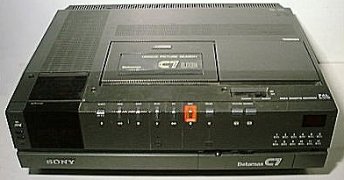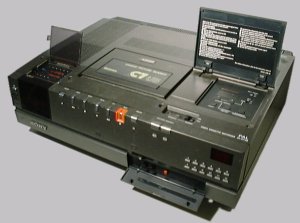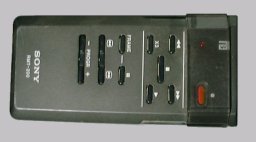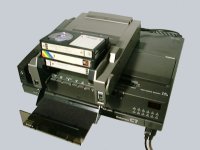 |
|
 |
|
 |
|
 |
|
 |
||||||
|
||||||
 |
 |
|||||
 |
FORMAT: Betamax | |||||
DATE: 1981 PRICE: £600 [2005: £1540] 49x38x16cm 15.5kg |
||||||
 |
 |
|
|
||||||||||||||||||||||||||||||
| Although still a huge, heavy breeze-block of a machine, and despite being a top-loader, the C7 was a startlingly sophisticated machine for 1981. It was the first Beta or VHS machine to have full logic-controlled operating keys and colour picture search; it also had variable speed slow-motion (half speed down to freeze-frame), triple-speed fast play, audio dub, a multi-event timer and electronic tuning. This sophistication ensured that the C7 would become one of the classic Betamax decks. | |
| The silver control buttons, arranged along the front edge of the gunmetal-coloured case, can be pressed from either above or in front. They are electronic switches, so all the mechanical actions required by the function selected are driven by motors and solenoids, rather than by the mechanical force exerted by the user as in a piano-key machine. This allows a one-button record (as opposed to the Play + Record combination usually required) which is convenient but dangerous, as it's easier to accidentally record over a tape. The record button is flagged with a red surround and recessed to help prevent this. |  |
| Other unusual control features are the separate buttons for picture search - rather than using the existing
Fast Forward and Rewind buttons - and the slider which controls the slow-motion feature. This slider affects the meaning
of the Pause button, giving still-frame at the left and variable-speed slow-motion as its moved to the right. There is
also a separate Frame Advance button.
The timer and clock setting controls are under a perspex f lap above the clock display. Four programs can be set up, up to two weeks ahead; weekly and daily recording is possible, and a proper end-time was entered, rather than selecting one of a set of pre-defined recording lengths. By leaving the end-time blank, the recording would continue until the end of the tape. |
| The tuner is under another flap on the top, and is a fully automatic search-and-store system: the search button
scans the airwaves until it finds a strong signal, which can then be stored as one of 12 available channels.
The first-time user can set up the machine with a single keypress: Automatic Programming assigns all the strong
signals it can find to each of the 12 available channels in turn. This is very sophisticated, but does mean that the
stations will be on random buttons - BBC1 will probably not be channel 1, and so on.
Under a flap at the bottom are three switches, for Audio Dub, End Alarm, and APS. End alarm is simply a beeper which sounds when the tape reaches the end, but APS is an altogether more interesting feature. Like many modern VHS machines, the C7 marks the beginning of each recording with an invisible signal recorded on the tape, and when winding or rewinding in APS mode, the machine will stop when it sees one of these cue markers. |
|
 |
The C7 came with an infra-red remote controller as standard, which gave full control over record, playback and channel selection - though you couldn't work the slow-motion system remotely. Unlike the deck itself, the remote has a transparent safety cover which can be used to protect the record button from accidental presses. Having had my cat treading on the record button of a remote, erasing an important recording, I can vouch for the usefulness of this electronic condom! |
| The C7 could also be used with the startlingly bizzarre BetaStack tape changer. This amazing machine, which allowed
up to four tapes to be recorded or played in sequence, is covered in its own exhibit in
room 12.
The AG-C7 BetaStack |
 |